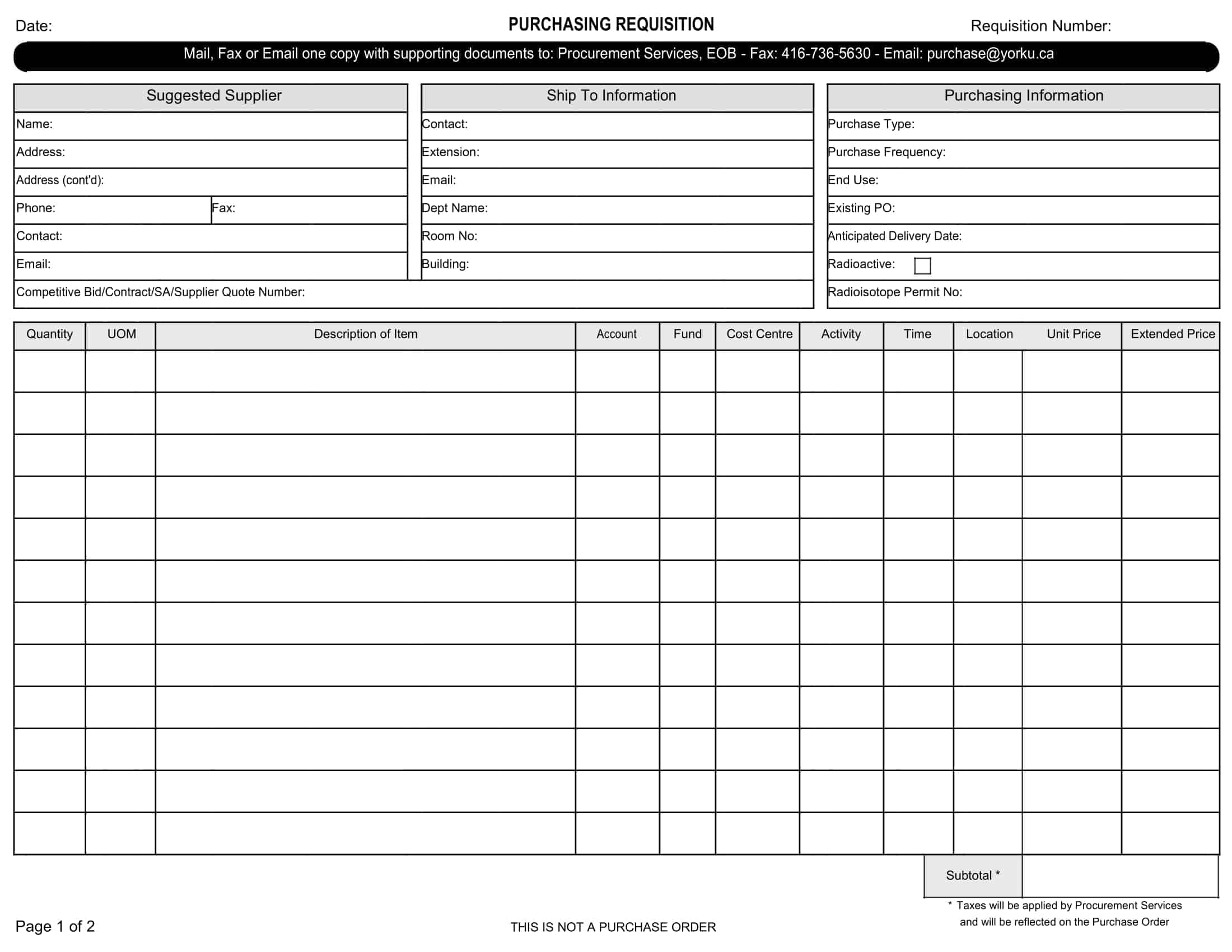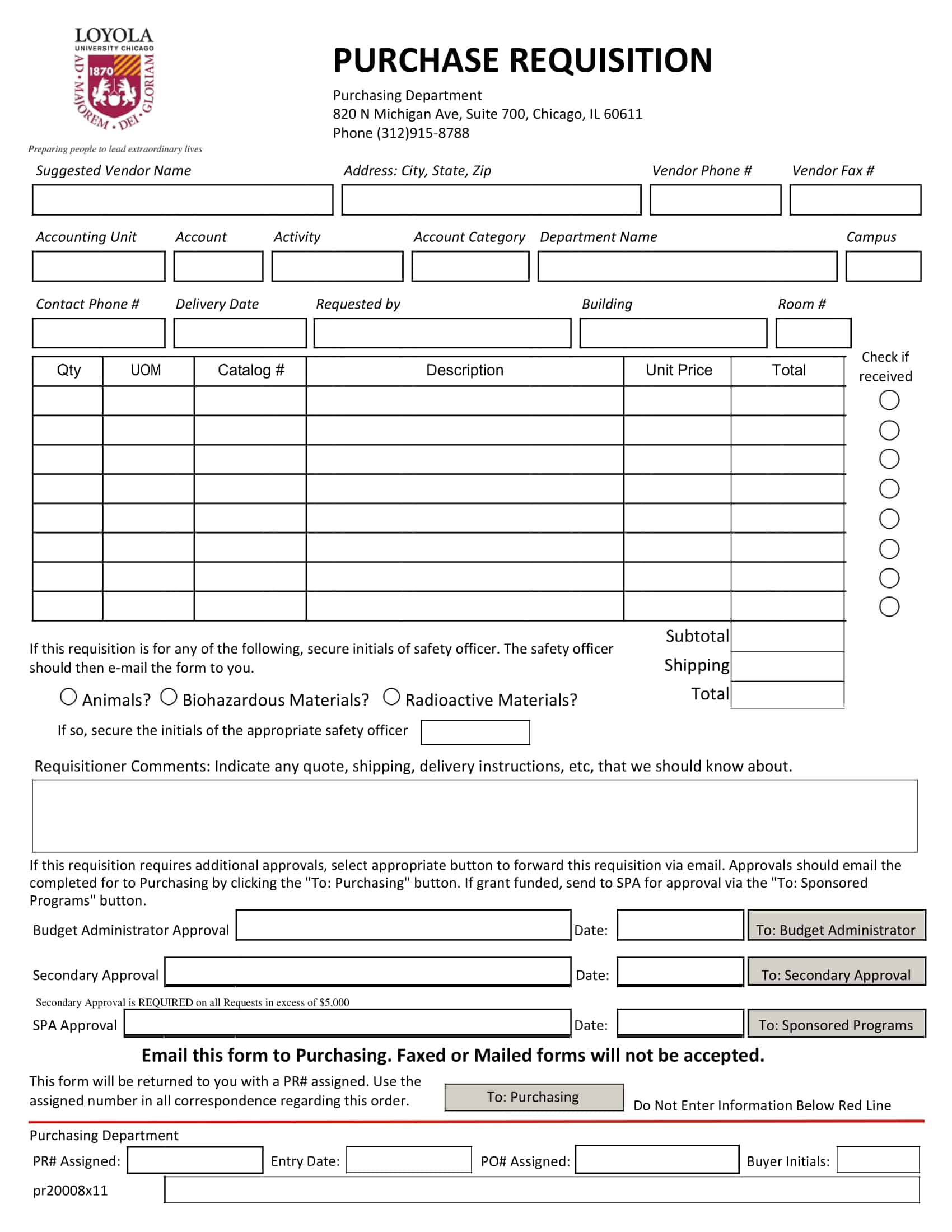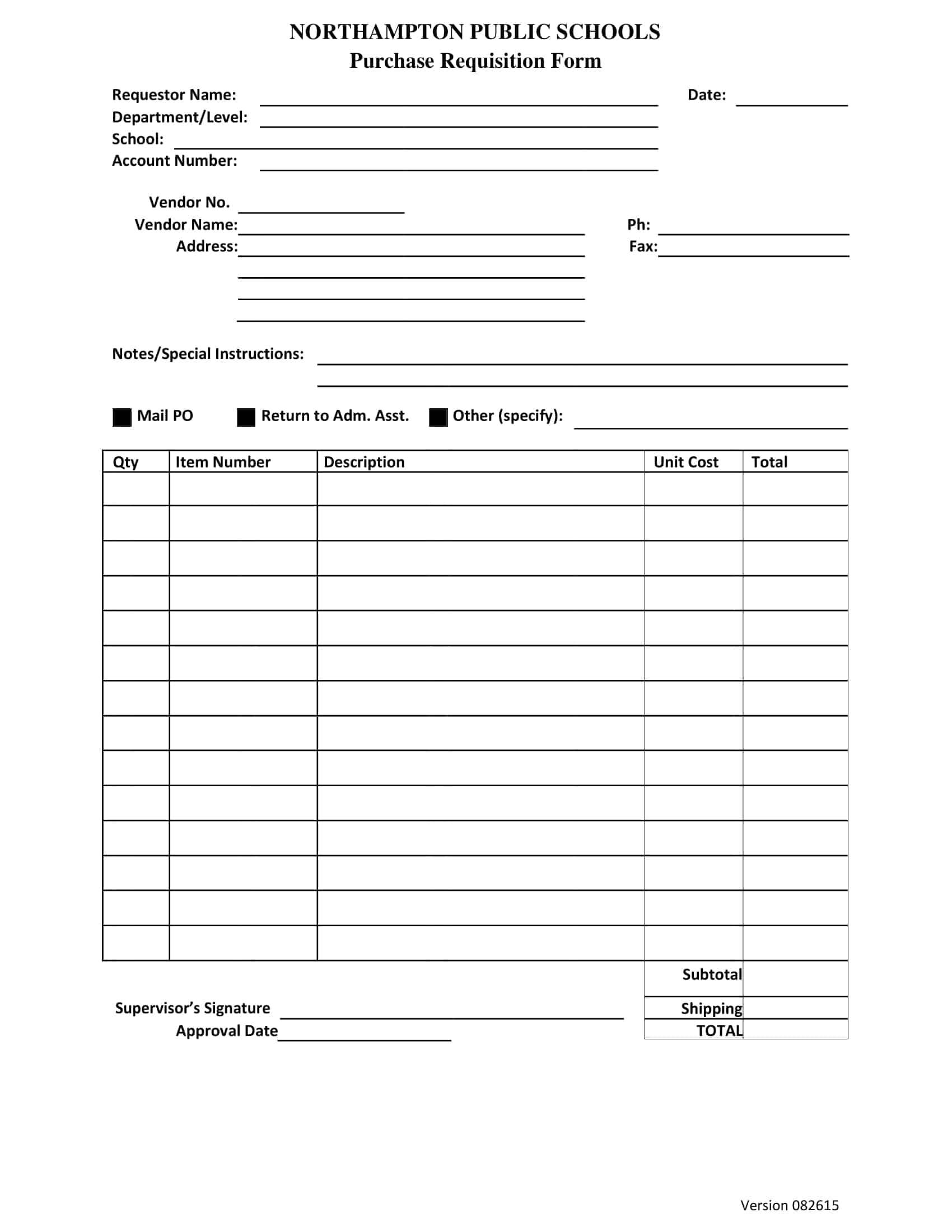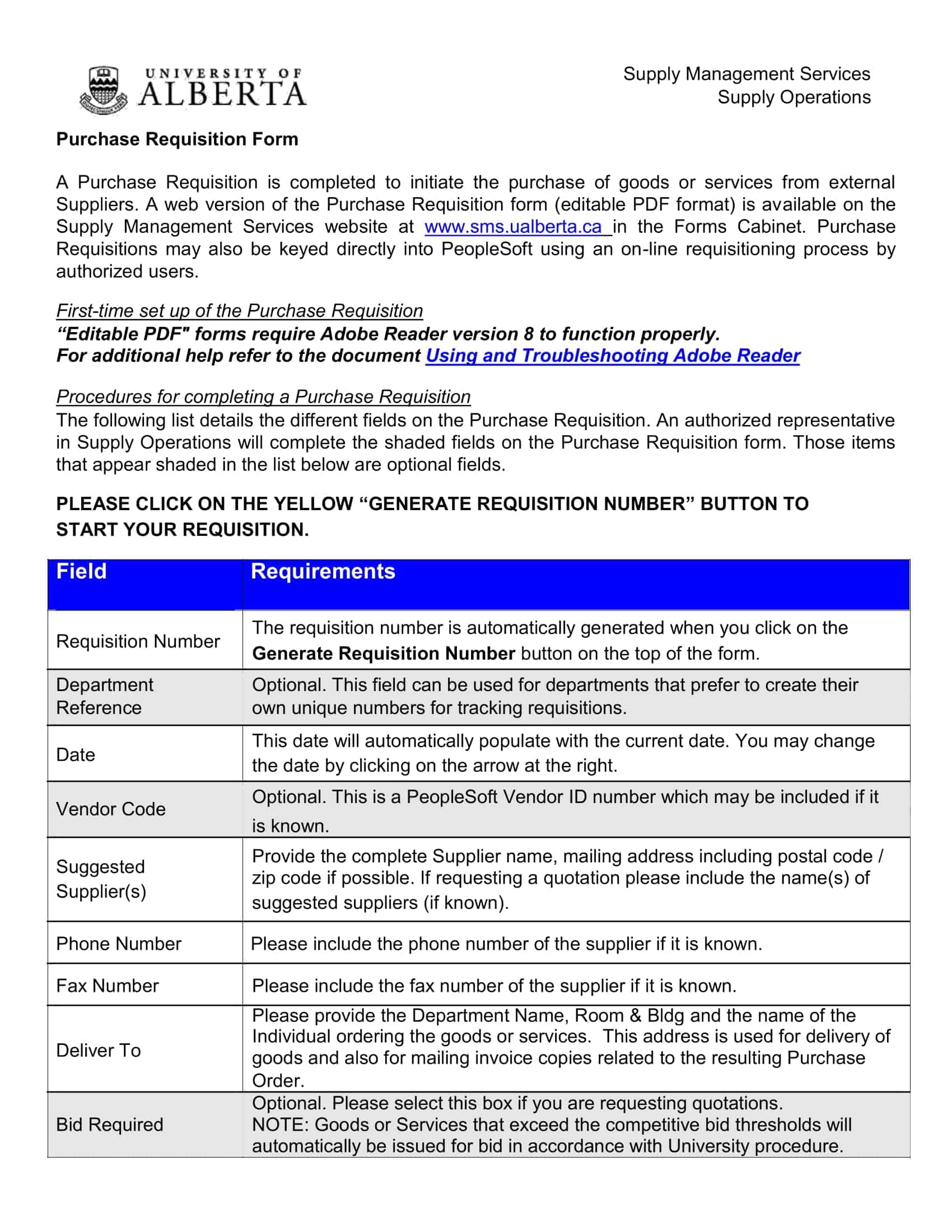A requisition form is a document used to request goods, services, or equipment from an external source. It is typically used by employees within a company to request items they need to complete their job tasks. The form includes information such as the item being requested, the quantity needed, and the reason for the request.
It also includes information about the requester, such as their name and department. Approval from the appropriate supervisor or manager is typically required before the requisition can be fulfilled. In this article, we will discuss the various elements of a requisition form, as well as how to properly fill one out and submit it for approval.
Table of Contents
Requisition Form Templates
Simplify your procurement process and ensure accurate supply management with our comprehensive collection of Requisition Form Templates. Whether you’re a business in need of essential supplies, a department requesting equipment, or an organization seeking services, our templates provide a user-friendly framework for submitting formal requests.
These customizable and printable templates include sections for item descriptions, quantities, budget codes, and any specific requirements. By utilizing our Requisition Form Templates, you can streamline the request process, maintain consistency, and ensure efficient communication with your procurement team or suppliers. Save time and enhance your supply chain management efforts by downloading our templates now. Request the resources you need with confidence and keep your operations running smoothly.
Key elements of a requisition form

The elements of a requisition form can vary depending on the specific organization or company, but generally, they include the following:
Requestor information: This includes the name, department, and contact information of the person making the request.
Item information: This includes a description of the item being requested, the quantity needed, and any relevant details such as size, color, or model number.
Reason for request: This section should provide a clear explanation of why the item is needed and how it will be used.
Approval signature: This section is used to indicate that the request has been reviewed and approved by the appropriate supervisor or manager.
Budget information: This may include information on the budget code or account that the request will be charged to.
Date of request: This is the date when the requisition form was filled out and submitted.
Delivery information: This includes the expected delivery date, shipping address, and any special instructions for delivery.
Attachments: This includes any additional documentation that may be required such as quotes, estimates, or purchase order numbers.
Types of requisition forms
There are several types of requisition forms that organizations use to request goods, services, or equipment. Some common types include:
Purchase requisition form: This type of form is used to request goods or services from an external vendor or supplier. It typically includes information about the item being requested, the quantity needed, and the reason for the request, as well as the budget allocation and delivery information.
Internal requisition form: This type of form is used to request goods or services from within the organization. It is commonly used to request items from a company’s storeroom or warehouse.
Maintenance requisition form: This type of form is used to request maintenance or repairs for equipment or facilities. It typically includes information about the equipment or facility, the nature of the problem, and the requested resolution.
Travel requisition form: This type of form is used to request travel-related expenses such as airfare, hotel accommodations, and rental car. It typically includes information about the destination, the dates of travel, and the purpose of the trip.
Capital requisition form: This type of form is used to request capital expenditures such as new equipment or building renovations. It typically includes information about the item being requested, the reason for the request, and the budget allocation.
Advance requisition form: This type of form is used to request an advance payment for goods, services, or expenses that will be incurred in the future. It typically includes information about the item being requested, the reason for the request, and the budget allocation.
Materials requisition form: This type of form is used to request raw materials, supplies, or components that are needed to complete a project or production process. It typically includes information about the materials being requested, the quantity needed, and the reason for the request.
Personnel requisition form: This type of form is used to request the hiring of a new employee, or a temporary worker. It typically includes information about the position being requested, the qualifications of the candidate, and the budget allocation.
Test or laboratory requisition form: This type of form is used to request laboratory tests, experiments or analysis to be performed. It typically includes information about the samples, type of test, and reason for the request.
Services requisition form: This type of form is used to request specific services such as consulting, training, or legal services from external providers. It typically includes information about the service being requested, the reason for the request and the budget allocation.
These forms can be created in paper or digital format, and can be managed by using special software for requisition management.
What is the purpose of a requisition form?
A requisition form is a document used to request goods, services, or equipment from an external vendor or supplier, or from within an organization. It is typically used to initiate the procurement process and includes information such as the item being requested, the quantity needed, the budget allocation, and the reason for the request. The purpose of a requisition form is to provide a clear and comprehensive request for items needed, and to ensure that the procurement process is carried out efficiently and effectively.
Purchase Requisition vs Purchase Order: What’s the Difference?
Purchase requisition and purchase order (PO) are both documents used in the procurement process, but they serve different purposes and are used at different stages of the process.
A purchase requisition is a document that initiates the procurement process. It is typically created by a department or individual within an organization who needs to request goods, services, or equipment. The requisition includes details such as the item being requested, the quantity needed, the budget allocation, and the reason for the request. The requisition is then reviewed and approved by the appropriate parties before it is converted into a purchase order.
A purchase order, on the other hand, is a legally binding document that confirms a buyer’s intent to purchase goods or services from a supplier. It includes details such as the item being purchased, the quantity, the price, and the delivery schedule. A purchase order is typically issued after a purchase requisition has been reviewed and approved. It serves as the official record of the transaction, and it is sent to the supplier.
In summary, a purchase requisition is a internal document used to request goods, services or equipment, while a purchase order is a legal document that confirms the purchase, and it is sent to the supplier.
How Does the Purchase Requisition Form Process Work?
The purchase requisition form process is a multi-step process that is used to request goods, services, or equipment from an external vendor or supplier, or from within an organization. The process typically includes the following steps:
Initiation
The process begins when an individual or department within the organization identifies a need for goods, services, or equipment. They will then create a purchase requisition form to request these items. The form includes details such as the item being requested, the quantity needed, the budget allocation, and the reason for the request.
Approval
The purchase requisition form is then reviewed and approved by the appropriate parties. This may include the department manager, the budget manager, or the purchasing department. The approval process ensures that the request is valid, necessary, and within budget.
Sourcing
Once the requisition is approved, the purchasing department will begin the process of sourcing the goods, services, or equipment. This may include identifying potential suppliers, obtaining quotes, and evaluating the supplier’s capabilities. The purchasing department will then select the most suitable supplier based on factors such as price, quality, and delivery schedule.
Purchase Order
Once the supplier has been selected, the purchasing department will create a purchase order (PO). The PO is a legally binding document that confirms the buyer’s intent to purchase goods or services from the supplier. It includes details such as the item being purchased, the quantity, the price, and the delivery schedule. The PO is then sent to the supplier for their acceptance.
Delivery
The supplier will then prepare and ship the goods or services to the buyer. The buyer will inspect the goods or services upon receipt to ensure that they meet the specifications outlined in the PO.
Invoice and Payment
Once the goods or services have been received and accepted, the supplier will send an invoice to the buyer for payment. The invoice should match the PO and the buyer will process the payment.
Close out
Upon receipt of payment, the purchase requisition process is complete. The purchasing department will then close out the purchase order and file the relevant documents for future reference.
Throughout the purchase requisition process, it is important that all parties involved adhere to proper documentation and record-keeping practices. This will ensure that all transactions are tracked and recorded accurately, and that any issues or discrepancies can be identified and resolved quickly. Additionally, the process is often automated with the help of procurement software which makes it easier to track, manage, and approve purchase requisition.
FAQs
Who creates a requisition form?
A requisition form is typically created by a department or individual within an organization who needs to request goods, services, or equipment. The form is then reviewed and approved by the appropriate parties before it is converted into a purchase order.
Can requisition forms be automated?
Yes, requisition forms can be automated with the help of procurement software. Automation can make it easier to track, manage, and approve purchase requisition, and can reduce the risk of errors.
Who approves a requisition form?
Requisition forms are typically reviewed and approved by the appropriate parties within the organization. This can include managers, supervisors, or department heads, depending on the organization’s internal procedures.
How long does it take for a requisition form to be processed?
The time it takes for a requisition form to be processed can vary depending on the organization’s internal procedures, the complexity of the request, and the availability of goods or services from the supplier. It is important to communicate clearly with the supplier and ensure that all necessary information is provided to ensure a smooth and efficient process.
Are requisition forms legally binding?
No, requisition forms are not legally binding. They are used to initiate the procurement process and request goods or services, but they do not formally commit the organization to a purchase. A purchase order is the legally binding document that confirms a buyer’s intent to purchase goods or services from a supplier.




















































![Free Printable Food Diary Templates [Word, Excel, PDF] 1 Food Diary](https://www.typecalendar.com/wp-content/uploads/2023/05/Food-Diary-1-150x150.jpg 150w, https://www.typecalendar.com/wp-content/uploads/2023/05/Food-Diary-1-1200x1200.jpg 1200w)
![Free Printable Credit Card Authorization Form Templates [PDF, Word, Excel] 2 Credit Card Authorization Form](https://www.typecalendar.com/wp-content/uploads/2023/06/Credit-Card-Authorization-Form-150x150.jpg)
![Free Printable Stock Ledger Templates [Excel,PDF, Word] 3 Stock Ledger](https://www.typecalendar.com/wp-content/uploads/2023/08/Stock-Ledger-150x150.jpg)
